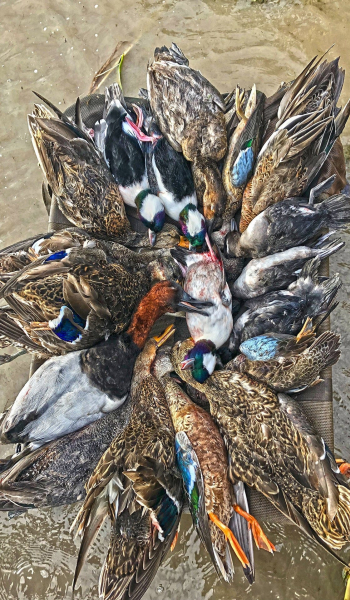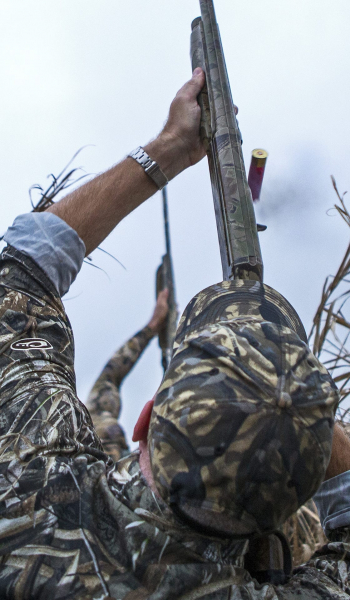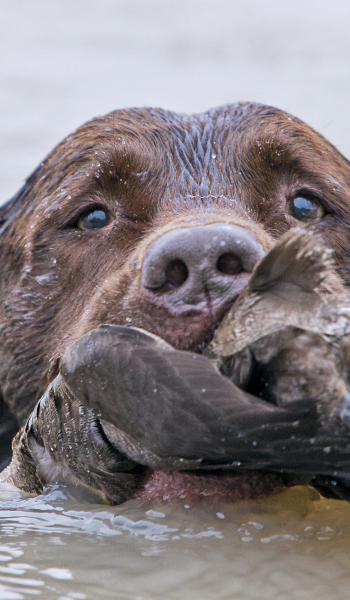Frequently Asked Questions
What is the Thunderbird Hunting Club (THC)?
We are a true “Hunting Club”, not an outfitter with guided hunts, day hunts, or lease broker. Thunderbird is for the “do it yourself” duck hunter that takes pride in hunting for their own ducks. It is also for those who are new to the sport and want to learn with ample opportunities (tough to learn if you don’t have a lot of ducks or your hunting lease is poorly managed). 101% of our efforts go into the members, the club, and making great habitat. We offer individual memberships and limited corporate memberships. Our mission is to provide our members with a quality outdoor experience and to provide the very best habitat we can for waterfowl. Everyone is treated equal and we play no favorites in the selection of blinds or fields. You will not compete with guides, managers, or owners for the best spots. The best spots are for you the member. We have an abundance of “best spots” due our proven management program, limited membership, and restricted guest policy (too many guests will ruin your duck hunting).
Rest assured you will be hunting with one of the best duck clubs in Texas, if not the entire nation. Our duck hunting is with no equal, period!
How is your hunting?
Two words best summarize our hunting—outstanding and consistent. Through droughts, floods, mild weather, stalled migrations it doesn’t matter, we shoot birds, day after day, month after month, year after year. We don’t have to make excuses for why there are no ducks over your decoys. Thunderbird Hunting Club is now know as one of the best, if not the best duck hunting clubs in the nation!
This past season (2023-2024) the club harvested 10,767 waterfowl with a daily average of 21.7 birds per 4-man duck blind with 70% of our 4-man groups returning with full 24-duck limits. These are all unguided hunts!
We have had Ducks Unlimited (DU) TV film two episodes at the club and have had DU Nation film three shows for their YouTube channel. DU goes where the ducks are.
Are duck numbers down in Coastal Texas?
Yes and no.
Last season, 2023-2024, the club had yet another record-breaking season with close to 11,000 birds harvested, perhaps the highest in the nation, so no shortage of ducks at Thunderbird. However, many areas reported poor duck hunting.
For the 2022-2023 season the club broke almost all of its outstanding numbers from previous seasons with close to 9,500 birds harvested, up 25% from the previous season. Yet during the Texas Parks & Wildlife Department’s mid-winter aerial duck survey was -28% from the last year’s survey and the 2nd lowest in over 27-years. This speaks loud and clear the importance of making good habitat for ducks and controlling the hunting pressure.
During the 2020-2021 season, the club harvested more ducks up +12% from 7,062 birds to 7,990 birds, at the same time coastal duck numbers were down -10% from the annual mid-season waterfowl season by Texas Parks and Wildlife Department.
During the 2019-2020 season duck numbers statewide dropped -9% from the previous season, yet the club also had a record season going from 5,613 birds to 7,062 birds, a substantial increase of +21%.
During the extremely wet 2018-2019 season our numbers did drop a little -8% (6,093 to 5,613), however at the same time state duck numbers dropped -50% and coastal ducks dropped a whopping -76%!
Proof positive that Thunderbird attracts waterfowl like no one else and provides the absolute best duck hunting anywhere.
Ducks are adaptive in modern times and are learning how to survive with ever increasing human encroachment. Next time you hear, “The ducks just have just not migrated to Texas” think again, there are in large concentrations in select areas, ducks have just learned how to quickly find refuge on unpressured waters with good habitat.
What do you attribute to the success of THC?
Keys include good organization and communication, working extremely hard year-round, making great habitat, keeping the habitat alive during with season with fresh water, controlling hunting pressure, and our great members who work hand in hand in making the club what it is.
Thunderbird has been in business for 38-years, few outfitters can say this, and we have seen countless guided operations and clubs go out of business over the years. You have to be adaptable to conditions and a good businessman to stay afloat; It is extremely expensive to run a good hunting operation.
Year after year you can count on Thunderbird to be there to provide you with the finest duck hunting possible.
Do you limit how many members are in the club?
Very much so, as stated Thunderbird is about quality. Too many members, and especially too many guests, results in calamity, we hear about it from others every single season. We think the size of the club is perfect with enough water to move members around on birds, yet at the same time small enough to learn in one season and not be impersonal. Because we have an abundance of “good spots” it is not competitive among the membership, old members help new members learn the ropes, something we are very proud of and unique at Thunderbird.
How many acres does the club have?
Actually, the question should be, “How many acres of quality habitat will I be able to hunt?” It is not the quantity of land, rather it is the quality of habitat per the hunting pressure that really matters. If you put together, side-by-side, all the wetlands habitat the club manages, it would cover an area 5-miles square wide! Great habitat and limited guns are the keys to having great hunts, it is what we do best.
Why do your members shoot so many birds?
Three truths; making and maintaining habitat, controlling and enforcing hunting pressure, and communication with the membership, easy to say, difficult to produce. A good friend of ours in Ducks Unlimited once said, “Making good waterfowl hunting is not Rocket Science, it is much harder!”
Any successful business crunches numbers rather than rely on gut-instincts. At Thunderbird we fanatical about the stats, they tell us what we are doing right, where we need to improve. We know exactly how many hunters we average on any given day, how cost effective a property in terms of waterfowl harvested, how many guests hunt at the club, what pond produces the most limits of ducks, the costs on each duck shot on a given pond, etc. We have been keeping numbers for over a decade on the club. Statistics helps us not only manage the properties / habitat more efficiently, it also helps us regulate the gunning pressure to assure quality hunting for the membership.
Nothing attracts ducks like food and ducks on the water, that is why we are adamite about resting our ponds properly and rotating the properties as needed to put ducks over the decoys. We hunt only one group of 3-4-guns / pond, not 6-8 guns per blind and/or multiple groups hunting on same pond. This means you get to work your ducks into the decoys rather than having to pass shoot sky-high ducks because someone is hunting on top of you. The club hunts ducks on Wednesday, Saturday, and Sunday only.
Nothing attracts waterfowl to an area than good habitat and undisturbed conditions. Ducks attract ducks. Shoot them all off your property and you may not have any birds for quite some time.
How do you make good habitat?
Making great habitat for the waterfowl to feed and roost in is a year-round endeavor at Thunderbird; discing, shredding, planting of food, aerial spraying, controlling water clarity for aquatic plant growth, installing intermediate levees and water control structures for proper water levels are a few of things we do. “A POND FILLED WITH WATER IS NOT A DUCK POND.” We have seen “folks” take over great leases, only to have them fail as “duck ponds” instantly the first year. To be successful you must know how to farm food for waterfowl and know what they like to eat. You also need to provide food not just during the beginning of the season, but through to the end of the season as well. On staff are two degreed (Wildlife & Horticultural) experts and owners in the cultivation of waterfowl foodstuffs. It is very expensive to manage properly and takes years of experience to get it right. Read recent article in website by Todd Steele under Media / Steele Articles / Important Waterfowl Foods Along the Gulf Coast. All of our properties have deep-water wells that allow us to pump water when the habitat needs it. This is extremely important, as controlling water levels are critical to attracting and keeping waterfowl. In addition, you must have the ability to pump water in the fall and winter to keep aquatics alive, once they dry out the food source is gone for the season!
Thunderbird has deep enough pockets to keep the water wells running for maintaining habitat and continual attraction of birds. Last season was an exceptional drought, but we keep the wells running, some for five months straight. Next time you see a big home water bill think of Thunderbird, last season our water bill was close to $150,000! And that does not include all the other expensive costs going into our habitat and operations.
How do I know where the best waterfowl hunting is occurring?
If you are not hunting were the waterfowl were the day before, the odds are great you will not have a very good hunt. We put a great deal of effort and time in getting the members on birds. During duck season the club has bi-weekly Scouting Reports on where we found birds, weekly Newsletters (see examples in website under Media) , flash-memos, Friday evening lodge discussions on the birds, and members have direct access to all of our managers. Countless man-hours are spent throughout the season to help each and every member hunt the exact “X” for shooting loads of birds on each and every hunt! Our results speak for themselves. In addition, starting in September and going into January we post our weekly Migration Report (examples in website under Migration Report)), this gives you up to date information on migrations of birds, both in the Central Flyway and along the Texas Gulf Coast, gathered from dozens of sources.
We have two mapping system tools that help new members “find their way in the dark.” Up to date maps in our “Members Only” section and our new Thunderbird Google Drive where satellite images of properties and ponds are overlaid with roads, parking areas, duck blinds, etc. In addition old members are always helping new members in the morning. It is extremely rare for any of our members to not find their pond / duck blind in the morning, even new members.
In August we have two dog-and-pony shows of the properties. Members may also join any of the managers as they scout properties the day before the hunts (note we do not allow members to scout on their own).
What else can I do at the Thunderbird?
Included in your membership; dove hunting, goose/crane hunting, snipe / rail hunting, saltwater fishing on two private marsh systems, and hog hunting.
Other activities include; kayaking, crabbing, gathering oysters, clay-bird shooting, retriever training, lodge cookouts, and group get-togethers at the lodge.
We have heard this often, “When I arrive at the hunting lodge it seems like all the problems of the world are lifted. “Nothing like relaxing on the front porch with a “cold-one” and enjoying your passion with others.
Is the lodge included in my membership?
Yes, your membership entitles you to use of the lodge year-round, per calendar year starting March 1. Lodge is fully furnished with all the comforts of home. For an additional fee THC has limited RV Trailer Pads and Private Cabins all with full utilities.
When are the dues do?
50% deposit is due upon joining. 50% of the remainder of the dues is due August 1.
How do I Join?
First, we need to make sure Thunderbird is a good fit for both sides. Second, we need to check if there are any openings in the club.
Sorry the club is full for the 2024-2025 season and currently the waitlist is full for the 2025-2026 season.



